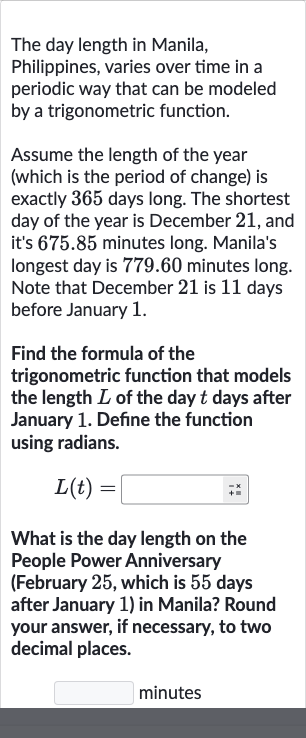AI tutor
Welcome to Bytelearn!
Let’s check out your problem:

The day length in Manila, Philippines, varies over time in a periodic way that can be modeled by a trigonometric function.Assume the length of the year (which is the period of change) is exactly days long. The shortest day of the year is December , and it's . minutes long. Manila's longest day is . minutes long. Note that December is days before January .Find the formula of the trigonometric function that models the length of the day days after January . Define the function using radians.What is the day length on the People Power Anniversary (February , which is days after January ) in Manila? Round your answer, if necessary, to two decimal places.minutes
Full solution
Q. The day length in Manila, Philippines, varies over time in a periodic way that can be modeled by a trigonometric function.Assume the length of the year (which is the period of change) is exactly days long. The shortest day of the year is December , and it's . minutes long. Manila's longest day is . minutes long. Note that December is days before January .Find the formula of the trigonometric function that models the length of the day days after January . Define the function using radians.What is the day length on the People Power Anniversary (February , which is days after January ) in Manila? Round your answer, if necessary, to two decimal places.minutes
- Determine Amplitude: Determine the amplitude of the trigonometric function.The amplitude is half the difference between the longest and shortest day lengths.Amplitude = Amplitude = Amplitude = Amplitude = minutes
- Determine Vertical Shift: Determine the vertical shift of the trigonometric function.The vertical shift is the average of the longest and shortest day lengths.Vertical shift = Vertical shift = Vertical shift = Vertical shift = minutes
- Determine Period: Determine the period of the trigonometric function.The period is the length of the year, which is given as days.Period days
- Convert to Radians: Convert the period into radians.Since the period is one year and a full cycle in radians is , the conversion factor is radians per days.Conversion factor =
- Determine Horizontal Shift: Determine the horizontal shift of the trigonometric function.The shortest day is on December , which is days before January . Therefore, the horizontal shift is days to the right.Horizontal shift = days
- Write Trigonometric Function: Write the trigonometric function using the values found.The general form of a sinusoidal function is , where:- is the amplitude,- is the frequency (related to the period by ),- is the horizontal shift, and- is the vertical shift.Using the values found:- ,- ,- ,- .The function is .
- Calculate Day Length: Calculate the day length on February , which is days after January .Plug into the function .Now calculate the cosine value and then the entire expression.
- Perform Calculation: Perform the calculation for the cosine value and the entire expression.First, calculate the argument of the cosine function:Now, calculate the cosine of this value and then multiply by the amplitude: (using a calculator)Finally, add the vertical shift: minutesRound to two decimal places: minutes
More problems from Write exponential functions: word problems
QuestionGet tutor help
QuestionGet tutor help
QuestionGet tutor help
QuestionGet tutor help
QuestionGet tutor help
QuestionGet tutor help
QuestionGet tutor help
QuestionGet tutor help
QuestionGet tutor help
